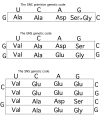An extension of the coevolution theory of the origin of the genetic code
- PMID: 18775066
- PMCID: PMC2538516
- DOI: 10.1186/1745-6150-3-37
An extension of the coevolution theory of the origin of the genetic code
Abstract
Background: The coevolution theory of the origin of the genetic code suggests that the genetic code is an imprint of the biosynthetic relationships between amino acids. However, this theory does not seem to attribute a role to the biosynthetic relationships between the earliest amino acids that evolved along the pathways of energetic metabolism. As a result, the coevolution theory is unable to clearly define the very earliest phases of genetic code origin. In order to remove this difficulty, I here suggest an extension of the coevolution theory that attributes a crucial role to the first amino acids that evolved along these biosynthetic pathways and to their biosynthetic relationships, even when defined by the non-amino acid molecules that are their precursors.
Results: It is re-observed that the first amino acids to evolve along these biosynthetic pathways are predominantly those codified by codons of the type GNN, and this observation is found to be statistically significant. Furthermore, the close biosynthetic relationships between the sibling amino acids Ala-Ser, Ser-Gly, Asp-Glu, and Ala-Val are not random in the genetic code table and reinforce the hypothesis that the biosynthetic relationships between these six amino acids played a crucial role in defining the very earliest phases of genetic code origin.
Conclusion: All this leads to the hypothesis that there existed a code, GNS, reflecting the biosynthetic relationships between these six amino acids which, as it defines the very earliest phases of genetic code origin, removes the main difficulty of the coevolution theory. Furthermore, it is here discussed how this code might have naturally led to the code codifying only for the domains of the codons of precursor amino acids, as predicted by the coevolution theory. Finally, the hypothesis here suggested also removes other problems of the coevolution theory, such as the existence for certain pairs of amino acids with an unclear biosynthetic relationship between the precursor and product amino acids and the collocation of Ala between the amino acids Val and Leu belonging to the pyruvate biosynthetic family, which the coevolution theory considered as belonging to different biosyntheses.
Reviewers: This article was reviewed by Rob Knight, Paul Higgs (nominated by Laura Landweber), and Eugene Koonin.
Figures




Similar articles
-
The lack of foundation in the mechanism on which are based the physico-chemical theories for the origin of the genetic code is counterposed to the credible and natural mechanism suggested by the coevolution theory.J Theor Biol. 2016 Jun 21;399:134-40. doi: 10.1016/j.jtbi.2016.04.005. Epub 2016 Apr 8. J Theor Biol. 2016. PMID: 27067244
-
The genetic code is very close to a global optimum in a model of its origin taking into account both the partition energy of amino acids and their biosynthetic relationships.Biosystems. 2022 Apr;214:104613. doi: 10.1016/j.biosystems.2022.104613. Epub 2022 Jan 24. Biosystems. 2022. PMID: 35085754
-
Theories of the origin of the genetic code: Strong corroboration for the coevolution theory.Biosystems. 2024 May;239:105217. doi: 10.1016/j.biosystems.2024.105217. Epub 2024 Apr 24. Biosystems. 2024. PMID: 38663520
-
The historical factor: the biosynthetic relationships between amino acids and their physicochemical properties in the origin of the genetic code.J Mol Evol. 1998 Jun;46(6):615-21. doi: 10.1007/pl00006341. J Mol Evol. 1998. PMID: 9608043 Review.
-
Coevolution theory of the genetic code at age thirty.Bioessays. 2005 Apr;27(4):416-25. doi: 10.1002/bies.20208. Bioessays. 2005. PMID: 15770677 Review.
Cited by
-
Revisiting the physico-chemical hypothesis of code origin: an analysis based on code-sequence coevolution in a finite population.Orig Life Evol Biosph. 2013 Dec;43(6):465-89. doi: 10.1007/s11084-014-9353-x. Epub 2014 Feb 6. Orig Life Evol Biosph. 2013. PMID: 24500541
-
The Mutational Robustness of the Genetic Code and Codon Usage in Environmental Context: A Non-Extremophilic Preference?Life (Basel). 2021 Jul 30;11(8):773. doi: 10.3390/life11080773. Life (Basel). 2021. PMID: 34440517 Free PMC article.
-
A crescendo of competent coding (c3) contains the Standard Genetic Code.RNA. 2022 Oct;28(10):1337-1347. doi: 10.1261/rna.079275.122. Epub 2022 Jul 22. RNA. 2022. PMID: 35868841 Free PMC article.
-
The Coevolution of Biomolecules and Prebiotic Information Systems in the Origin of Life: A Visualization Model for Assembling the First Gene.Life (Basel). 2022 Jun 2;12(6):834. doi: 10.3390/life12060834. Life (Basel). 2022. PMID: 35743865 Free PMC article. Review.
-
Codon size reduction as the origin of the triplet genetic code.PLoS One. 2009 May 27;4(5):e5708. doi: 10.1371/journal.pone.0005708. PLoS One. 2009. PMID: 19479032 Free PMC article.
References
-
- Wong JT. Origin of genetically encoded protein synthesis a model based on selection for RNA peptidation. Orig Life Evol Biosph. 1991;21:165–176. - PubMed
-
- Wong JT, Xue H. Fundamentals of Life. Editions scientifiques et medicales Elsevier SAS, Paris; 2002. Self-perfecting evolution of heteropolymer building blocks and sequences as the basis of life; pp. 55–64.
-
- Di Giulio M. The early phases of genetic code origin: Conjectures on the evolution of coded catalysis. Orig Life Evol Biosph. 2003;33:479–489. - PubMed
-
- Di Giulio M. Why the Genetic Code Originated. Implications for the origin of protein synthesis. In: Barbieri M, editor. The Codes of Life: The Rules of Macroevolution. 2008. pp. 59–67.
-
- Nirenberg MW, Jones OW, Leder P, Clark BFC, Sly WS, Pestka S. On the coding of genetic information. Cold Spring Harbor Symp Quant Biol. 1963;28:549–557.
MeSH terms
Substances
LinkOut - more resources
Full Text Sources
Research Materials

